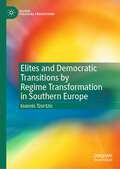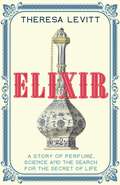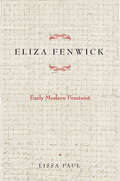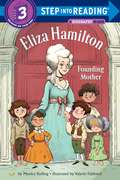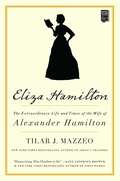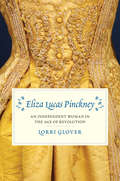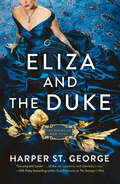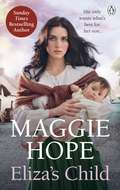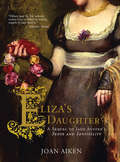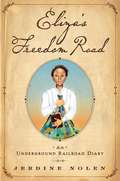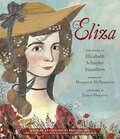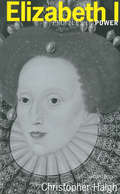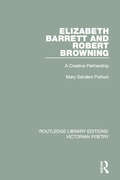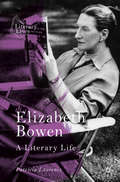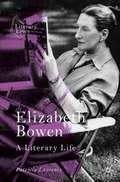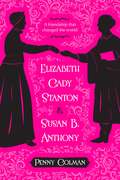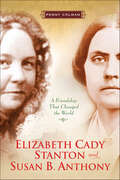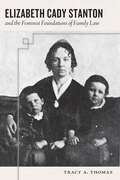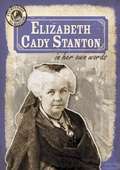- Table View
- List View
Elites and Democratic Transitions by Regime Transformation in Southern Europe (Global Political Transitions)
by Ioannis TzortzisThis book examines three cases of democratic transitions by self-transformation of the non-democratic regimes in Southern Europe—the Spanish reforma pactada-ruptura pactada of 1976-77, the Greek “Markezinis experiment” of 1973, and the Turkish democratic transition of 1983—in a comparative perspective. The author argues that a democratic transition initiated by the regime elites is, in contrast to widely held assumptions and notwithstanding some reservations on whether democracy can be (re-)introduced by non-democrats, worth viewing as a “window of opportunity” for democratisation. It is up to the democratic counter-elites to respond to it, using the civil society and the international factor as allies to achieve their goal of acquiring more concessions from the regime.
Elixir: A Parisian Perfume House and the Quest for the Secret of Life
by Theresa LevittA story of alchemy in Bohemian Paris, where two scientific outcasts discovered a fundamental distinction between natural and synthetic chemicals that inaugurated an enduring scientific mystery.For centuries, scientists believed that living matter possessed a special quality—a spirit or essence—that differentiated it from nonliving matter. But by the nineteenth century, the scientific consensus was that the building blocks of one were identical to the building blocks of the other. Elixir tells the story of two young chemists who were not convinced, and how their work rewrote the boundary between life and nonlife.In the 1830s, Édouard Laugier and Auguste Laurent were working in Laugier Père et Fils, the oldest perfume house in Paris. By day they prepared the perfumery’s revitalizing elixirs and rejuvenating eaux, drawing on alchemical traditions that equated a plant’s vitality with its aroma. In their spare time they hunted the vital force that promised to reveal the secret to life itself. Their ideas, roundly condemned by established chemists, led to the discovery of structural differences between naturally occurring molecules and their synthetic counterparts, even when the molecules were chemically identical.Scientists still can’t explain this anomaly, but it may point to critical insights concerning the origins of life on Earth. Rich in sparks and smells, brimming with eccentric characters, experimental daring, and the romance of the Bohemian salon, Elixir is a fascinating cultural and scientific history.
Elixir: A Story of Perfume, Science and the Search for the Secret of Life
by Theresa Levitt'Dizzying and fragrant . . . truly a captivating achievement!' Aimee Nezhukumatathil'If you read this book you will be changed . . . this book feels like an actual elixir' Kiese Laymon'A fascinating tale of discovery, wonder, and revolution' Matthew StanleyTwo friends in a Parisian perfume shop make a discovery that will transform our understanding of the world and the origins of life on Earth forever.Set amidst the unforgettable sights and smells of 18th and 19th Century Paris, Elixir tells the story of Edouard Laugier and Auguste Laurent, the son of a perfumer and a fellow aspiring chemist, who met on the Left Bank while pursuing their passion for science. Spurned by the scientific establishment, the pair ended up working out of Edouard's family perfume shop, Laugier père et fils. By day they prepared the revitalizing elixirs and rejuvenating eaux it was famous for, but by night using the ingredients of the perfumery and the principles of alchemy, they pursued the secret of life itself.Elixir reads like a novel, brimming with eccentric characters, experimental daring, and the romance of the Bohemian salon. It is the story of a long-standing scientific puzzle and the struggle to gain acceptance for a new way of thinking about the building blocks of living matter long after those who discovered it were both dead. Yet this is also a story of hope and determination. For while the scientific establishment ridiculed their work at the time, teenage lab assistant Louis Pasteur took it seriously and over the course of an exceptional career, was able to show that their work pointed to a deep, inexplicable asymmetry in the molecular arrangement of living things - an unexplained asymmetry which remains one of science's great mysteries.
Elixir: A Story of Perfume, Science and the Search for the Secret of Life
by Theresa LevittTwo friends in a Parisian perfume shop make a discovery that will transform our understanding of the world and the origins of life on Earth forever.Set amidst the unforgettable sights and smells of 18th and 19th Century Paris, Elixir tells the story of Edouard Laugier and Auguste Laurent, the son of a perfumer and a fellow aspiring chemist, who met on the Left Bank while pursuing their passion for science. Spurned by the scientific establishment, the pair ended up working out of Edouard's family perfume shop, Laugier père et fils. By day they prepared the revitalizing elixirs and rejuvenating eaux it was famous for, but by night using the ingredients of the perfumery and the principles of alchemy, they pursued the secret of life itself. Elixir reads like a novel, brimming with eccentric characters, experimental daring, and the romance of the Bohemian salon. It is the story of a long-standing scientific puzzle and the struggle to gain acceptance for a new way of thinking about the building blocks of living matter long after those who discovered it were both dead. Yet this is also a story of hope and determination. For while the scientific establishment ridiculed their work at the time, teenage lab assistant Louis Pasteur took it seriously and over the course of an exceptional career, was able to show that their work pointed to a deep, inexplicable asymmetry in the molecular arrangement of living things - an unexplained asymmetry which remains one of science's great mysteries.'Dizzying and fragrant, elegant and riveting . . . truly a captivating achievement!' Aimee Nezhukumatathil'If you read this book you will be changed . . . this book feels like an actual elixir. Absolutely stunning' Kiese Laymon(P) 2023 Hodder & Stoughton Limited
Eliza Fenwick: Early Modern Feminist (Early Modern Feminisms)
by Lissa PaulThis captivating biography traces the life of Eliza Fenwick, an extraordinary woman who paved her own unique path throughout the late eighteenth and nineteenth centuries as she made her way from country to country as writer, teacher, and school owner.Lissa Paul brings to light Fenwick’s letters for the first time to reveal the relationships she developed with many key figures of her era, and to tell Fenwick’s story as depicted by the woman herself. Fenwick began as a writer in the radical London of the 1790s, a member of Mary Wollstonecraft’s circle, and when her marriage crumbled, she became a prolific author of children’s literature to support her family. Eventually Fenwick moved to Barbados, becoming the owner of a school while confronting the reality of slavery in the British colonies. She would go on to establish schools in numerous cities in the United States and Canada, all the while taking care of her daughter and grandchildren and maintaining her friendships through letters that, as presented here, tell the story of her life.Distributed for the University of Delaware Press
Eliza Hamilton: Founding Mother (Step into Reading)
by Monica KullingA Step 3 BIOGRAPHY READER about the unsung historical figure and Founding Mother Elizabeth Schuyler Hamilton.Hamilton, the musical, is igniting American history fever in adults and kids--especially about the central figures of the play. Kids clearly want to know more, and this companion to early reader Alexander Hamilton: From Orphan to Founding Father will fill the void. Eliza Hamilton was so much more than just Alexander Hamilton's wife. She was a spirited girl who grew up to be a strong woman with a big heart and amazing strength of character. She rescued many children in need during her life. In fact, she and others established New York City's first orphanage--which became a place that is still helping needy children to this day. She lived for 50 years after Hamilton's death in the infamous duel, and she preserved his historical legacy and contributed to American history with other Founding Mothers in ways that will finally be shared widely with those newly interested in Colonial and Revolutionary War times. Step 3 Readers feature engaging characters in easy-to-follow plots about popular topics--for children who are ready to read on their own.
Eliza Hamilton: The Extraordinary Life and Times of the Wife of Alexander Hamilton
by Tilar J. MazzeoFrom the New York Times bestselling author of Irena’s Children comes a comprehensive and riveting biography of the extraordinary life and times of Eliza Hamilton, the wife of founding father Alexander Hamilton, and a powerful, unsung hero in America’s early days. Fans fell in love with Eliza Hamilton—Alexander Hamilton’s devoted wife—in Lin-Manuel Miranda’s phenomenal musical Hamilton. But they don’t know her full story. A strong pioneer woman, a loving sister, a caring mother, and in her later years, a generous philanthropist, Eliza had many sides—and this fascinating biography brings her multi-faceted personality to vivid life. Eliza Hamilton: The Extraordinary Life and Times of The Wife of Alexander Hamilton follows Eliza through her early years in New York, into the ups and downs of her married life with Alexander, beyond the aftermath of his tragic murder, and finally to her involvement in many projects that cemented her legacy as one of the unsung heroes of our nation’s early days. Featuring Mazzeo’s “impeccable research and crafting” (Library Journal), and perfect for fans of the richly detailed historical books by Ron Chernow and Erik Larson, Eliza Hamilton is the captivating account of the woman behind the famous man.
Eliza Lucas Pinckney: An Independent Woman in the Age of Revolution
by Lorri GloverThe enthralling story of Eliza Lucas Pinckney, an innovative, highly regarded, and successful woman plantation owner during the Revolutionary era Eliza Lucas Pinckney (1722–1793) reshaped the colonial South Carolina economy with her innovations in indigo production and became one of the wealthiest and most respected women in a world dominated by men. Born on the Caribbean island of Antigua, she spent her youth in England before settling in the American South and enriching herself through the successful management of plantations dependent on enslaved laborers. Tracing her extraordinary journey and drawing on the vast written records she left behind—including family and business letters, spiritual musings, elaborate recipes, macabre medical treatments, and astute observations about her world and herself—this engaging biography offers a rare woman&’s first-person perspective into the tumultuous years leading up to and through the Revolutionary War and unsettles many common assumptions regarding the place and power of women in the eighteenth century.
Eliza Pinckney: Women Of Colonial And Revolutionary Times
by Harriott Horry RavenelDiscover the remarkable life and legacy of one of Colonial America's most influential women in Harriott Horry Ravenel's captivating biography, "Eliza Pinckney." This meticulously researched book delves into the extraordinary story of Eliza Lucas Pinckney, whose innovations in agriculture and contributions to society left an indelible mark on the American South.Born in Antigua and raised in South Carolina, Eliza Pinckney's life was marked by resilience, intelligence, and a pioneering spirit. At a young age, she assumed the management of her family's plantations and began experimenting with indigo cultivation, a crop that would become a cornerstone of South Carolina's economy. Ravenel’s biography vividly portrays Eliza's innovative agricultural techniques and her success in establishing indigo as a profitable export, which had a lasting impact on the region’s prosperity.Through engaging narrative and rich historical detail, Ravenel captures Eliza’s multifaceted life, including her role as a devoted mother, wife, and community leader. The book highlights her correspondence with key figures of the time, providing insights into her thoughts and the challenges she faced as a woman in a predominantly male-dominated society."Eliza Pinckney" also explores her broader contributions to American history, from her influence on education and social welfare to her role in shaping the political landscape through her sons, Charles Cotesworth Pinckney and Thomas Pinckney, who became prominent statesmen.Ravenel's biography is not just a tribute to Eliza Pinckney's accomplishments but also a window into the complexities of colonial life and the pivotal role women played in shaping early American society.
Eliza Waite: A Novel
by Ashley E. Sweeney2017 Nancy Pearl Book Award After the tragic death of her husband and son on a remote island in Washington’s San Juan Islands, Eliza Waite joins the throng of miners, fortune hunters, business owners, con men, and prostitutes traveling north to the Klondike in the spring of 1898. When Eliza arrives in Skagway, Alaska, she has less than fifty dollars to her name and not a friend in the world—but with some savvy, and with the help of some unsavory characters, Eliza opens a successful bakery on Skagway’s main street and befriends a madam at a neighboring bordello. Occupying this space—a place somewhere between traditional and nontraditional feminine roles—Eliza awakens emotionally and sexually. But when an unprincipled man from her past turns up in Skagway, Eliza is fearful that she will be unable to conceal her identity and move forward with her new life. Using Gold Rush history, diary entries, and authentic pioneer recipes, Eliza Waite transports readers to the sights sounds, smells, and tastes of a raucous and fleeting era of American history.
Eliza and the Duke (The Doves of New York)
by Harper St. GeorgeAmerican heiress Eliza Dove was resigned to a polite marriage of convenience...until she spent one wicked night with the Duke. All hopeless romantic Eliza Dove asked for was one night of adventure. One glorious evening of freedom to explore the dark corners of London with a mysterious stranger before a lifetime trapped in a quiet, respectable marriage of convenience. Except now she wants more. Now she wants him. Simon Cavell is no gentleman. Known only as &‘the Duke,&’ Whitechapel&’s prize boxer is one fight away from achieving his goal: to safeguard his late sister&’s only treasure and leave the streets for good. He cannot allow some pretty young heiress to spill his secrets, no matter how tempting she might be. In return for her silence, Simon will give Eliza a taste of the darkness…and hope he doesn&’t lose his heart in the process. But one night together could never be enough. And now Eliza has a new plan—an even more scandalous bargain that will either land the heiress her duke or ruin them both.
Eliza's Child
by Maggie HopeTorn between love and duty...After the birth of their son, Eliza naively hopes her husband Jack will put his gambling habit behind him and become more responsible. But then he loses their home and abandons her, leaving Eliza with no choice but to return to her parents’ house.She inadvertently attracts the attention of the ruthless mine owner Jonathan Moore. But can she sacrifice her reputation to protect her son?
Eliza's Daughter
by Joan AikenA Young Woman Longing for Adventure and an Artistic Life... Because she's an illegitimate child, Eliza is raised in the rural backwater with very little supervision. An intelligent, creative, and free-spirited heroine, unfettered by the strictures of her time, she makes friends with poets William Wordsworth and Samuel Coleridge, finds her way to London, and eventually travels the world, all the while seeking to solve the mystery of her parentage. With fierce determination and irrepressible spirits, Eliza carves out a life full of adventure and artistic endeavor.
Eliza's Freedom Road
by Jerdine Nolen Shadra StricklandIt is 1852 in Alexandria, Virginia. An orphaned slave, twelve-year-old Eliza has only the quilt her mother left her and the memory of the stories she told. Stories become Eliza's lifeline to freedom after she takes to the night upon learning she will soon be traded. "Go East. Your back to the set of the sun until you come to the safe house where the candlelight lights the window." With the words of Old Joe, the farmhand, in her ears, Eliza travels by night and sleeps by day, keeping her diary along the way. Thoroughly researched by award-winning author Jerdine Nolin, Eliza's Freedom Road brings to life a historical period of pain and triumph. Vivid details and the emotional nature of Eliza's journal make her journey along the Underground Railroad powerful, accessible, and poignant.
Eliza: With an Afterword by Phillipa Soo, the Original Eliza from Hamilton: An American
by Margaret McNamaraFans of the musical Hamilton and their children won't want to miss this stunning picture book biography about Eliza Hamilton, American Founding Father Alexander Hamilton's extraordinary wife and an important figure in her own right. Includes an afterword from Phillipa Soo, the actress who originated the role of Eliza in Hamilton!We all know the story of scrappy Alexander Hamilton and his rise in American politics--but how much do we know about his workmate, inspiration, and stabilizing force, Elizabeth Schuyler Hamilton? Margaret McNamara employs the letter-writing style of the period to tell the story of Eliza Hamilton, who was born into a family of considerable wealth, power, and influence in Albany, New York, in 1757. Eliza was expected to marry into a similarly powerful family . . . until she met and fell in love with the charismatic Hamilton. She stood by him throughout his tumultuous life, and after his death, she single-handedly collected his papers and preserved them for historians and musical-theater writers of the future. Eliza outlived Hamilton by fifty years; during that time she founded the first orphanage in New York State, raised funds for the Washington Monument, and kept the flame of her husband's memory and achievements alive. This is a beautiful and informative biography featuring extensive back matter--including information about America's revolution, the historical relevance of letter writing, and a timeline--and exquisite, thoroughly researched art that mirrors paintings from 18th-century America. Every Hamilton lover will want to gift it to the young readers in their lives.
Elizabeth & Margaret: The Intimate World of the Windsor Sisters
by Andrew MortonPerfect for fans of The Crown, this captivating biography from a New York Times bestselling author follows Queen Elizabeth II and her sister Margaret as they navigate life in the royal spotlight.They were the closest of sisters and the best of friends. But when, in a quixotic twist of fate, their uncle Edward Vlll decided to abdicate the throne, the dynamic between Elizabeth and Margaret was dramatically altered. Forever more Margaret would have to curtsey to the sister she called 'Lillibet.' And bow to her wishes.Elizabeth would always look upon her younger sister's antics with a kind of stoical amusement, but Margaret's struggle to find a place and position inside the royal system—and her fraught relationship with its expectations—was often a source of tension. Famously, the Queen had to inform Margaret that the Church and government would not countenance her marrying a divorcee, Group Captain Peter Townsend, forcing Margaret to choose between keeping her title and royal allowances or her divorcee lover.From the idyll of their cloistered early life, through their hidden war-time lives, into the divergent paths they took following their father's death and Elizabeth's ascension to the throne, this book explores their relationship over the years. Andrew Morton's latest biography offers unique insight into these two drastically different sisters—one resigned to duty and responsibility, the other resistant to it—and the lasting impact they have had on the Crown, the royal family, and the ways it adapted to the changing mores of the 20th century.
Elizabeth & Philip: A Story of Young Love, Marriage, and Monarchy
by Tessa DunlopThis deeply moving story explores the attractions—and the tensions—that defined the most extraordinary royal marriage of the past seventy-five years.She was peaches-and-cream innocence; he was a handsome war hero. Both had royal blood coursing through their veins. The marriage of Britain's Princess Elizabeth to Lieutenant Philip Mountbatten in November 1947 is remembered as the beginning of an extraordinary lifelong union, but their success was not guaranteed. Elizabeth and Philip: A Story of Young Love, Marriage, and Monarchy plunges the reader back into 1940s Britain, where a teenage princess fell in love with a foreign prince. There were fears of a flirtatious "Greek" fortune hunter stealing off with England's crown jewels—and then subsequent efforts by the Establishment to reframe Philip as the perfect fit for Britain's most famous family. Drawing on original archives as well as interviews with Elizabeth and Philip's contemporaries who are still alive today, historian Dr. Tessa Dunlop discovers a post-war world on the cusp of major change. Unprecedented opinion on Philip's suitability was a harbinger of pressures to come for a couple whose marriage was branded the ultimate global fairytale. Theirs was a partnership like no other. Six years after Elizabeth promised to be an obedient wife, Philip got down on bended knee and committed himself as the queen's "liege man of life and limb." This deeply touching history explores the ups and downs, as well as the attractions and the tensions, that defined an extraordinary relationship. The high stakes involved might have devoured a less committed pair—but not Elizabeth and Philip. They shared a common purpose, one higher even than marriage, with roots much deeper than young love. Happy and glorious, for better or for worse, they were heavily invested in a God-given mission. Monarchy was the magic word.
Elizabeth (Profiles In Power)
by Christopher HaighThe reign of Elizabeth I was one of the most important periods of expansion and growth in British history, the so-called 'Golden Age'. This celebrated and influential study of Elizabeth reconsiders how she achieved this and the ways in which she exercised her power.
Elizabeth Barrett and Robert Browning: A Creative Partnership (Routledge Library Editions: Victorian Poetry #4)
by Mary Sanders PollockFirst published in 2003, this book examines the creative partnership of Elizabeth Barrett and Robert Browning, and provides a critical analysis of the poems written by this famous couple during the 16 year period of their friendship, courtship and marriage. Even quite early in their relationship, the Brownings shared a frame of reference: similar themes, narrative structures, and details of phrasing resonate in their works and suggest dialogue, rather than merely mutual influence. Pollock traces parallels between the Brownings' lives and works even before they met, and then throughout their courtship and married life, suggesting that their creative dialogue continued after Barrett Browning died in 1861, as her presence and themes continued to inform Browning's poetry for at least a decade afterward.
Elizabeth Bowen: A Literary Life (Literary Lives)
by Patricia LaurenceElizabeth Bowen: A Literary Life reinvents Bowen as a public intellectual, propagandist, spy, cultural ambassador, journalist, and essayist as well as a writer of fiction. Patricia Laurence counters the popular image of Bowen as a mannered, reserved Anglo-Irish writer and presents her as a bold, independent woman who took risks and made her own rules in life and writing. This biography distinguishes itself from others in the depth of research into the life experiences that fueled Bowen’s writing: her espionage for the British Ministry of Information in neutral Ireland, 1940-1941, and the devoted circle of friends, lovers, intellectuals and writers whom she valued: Isaiah Berlin, William Plomer, Maurice Bowra, Stuart Hampshire, Charles Ritchie, Sean O’Faolain, Virginia Woolf, Rosamond Lehmann, and Eudora Welty, among others. The biography also demonstrates how her feelings of irresolution about national identity and gender roles were dispelled through her writing. Her vivid fiction, often about girls and women, is laced with irony about smooth social surfaces rent by disruptive emotion, the sadness of beleaguered adolescents, the occurrence of cultural dislocation, historical atmosphere, as well as undercurrents of violence in small events, and betrayal and disappointment in romance. Her strong visual imagination—so much a part of the texture of her writing—traces places, scenes, landscapes, and objects that subliminally reveal hidden aspects of her characters. Though her reputation faltered in the 1960s-1970s given her political and social conservatism, now, readers are discovering her passionate and poetic temperament and writing as well as the historical consciousness behind her worldly exterior and writing.
Elizabeth Bowen: A Literary Life (Literary Lives)
by Patricia LaurenceElizabeth Bowen: A Literary Life reinvents Bowen as a public intellectual, propagandist, spy, cultural ambassador, journalist, and essayist as well as a writer of fiction. Patricia Laurence counters the popular image of Bowen as a mannered, reserved Anglo-Irish writer and presents her as a bold, independent woman who took risks and made her own rules in life and writing. This biography distinguishes itself from others in the depth of research into the life experiences that fueled Bowen’s writing: her espionage for the British Ministry of Information in neutral Ireland, 1940-1941, and the devoted circle of friends, lovers, intellectuals and writers whom she valued: Isaiah Berlin, William Plomer, Maurice Bowra, Stuart Hampshire, Charles Ritchie, Sean O’Faolain, Virginia Woolf, Rosamond Lehmann, and Eudora Welty, among others. The biography also demonstrates how her feelings of irresolution about national identity and gender roles were dispelled through her writing. Her vivid fiction, often about girls and women, is laced with irony about smooth social surfaces rent by disruptive emotion, the sadness of beleaguered adolescents, the occurrence of cultural dislocation, historical atmosphere, as well as undercurrents of violence in small events, and betrayal and disappointment in romance. Her strong visual imagination—so much a part of the texture of her writing—traces places, scenes, landscapes, and objects that subliminally reveal hidden aspects of her characters. Though her reputation faltered in the 1960s-1970s given her political and social conservatism, now, readers are discovering her passionate and poetic temperament and writing as well as the historical consciousness behind her worldly exterior and writing.
Elizabeth Cady Stanton and Susan B. Anthony: A Friendship That Changed the World
by Penny Colman<p>In the Spring of 1851 two women met on a street corner in Seneca Falls, New York—Elizabeth Cady Stanton, a thirty-five year old mother of four boys, and Susan B. Anthony, a thirty-one year old, unmarried, former school teacher. Immediately drawn to each other, they formed an everlasting and legendary friendship. Together they challenged entrenched beliefs, customs, and laws that oppressed women and spearheaded the fight to gain legal rights, including the right to vote despite fierce opposition, daunting conditions, scandalous entanglements and betrayal by their friends and allies. <p>Weaving events, quotations, personalities, and commentary into a page-turning narrative, Penny Colman tells this compelling story and vividly portrays the friendship between Elizabeth Cady Stanton and Susan B. Anthony, a friendship that changed history.</p>
Elizabeth Cady Stanton and Susan B. Anthony: A Friendship That Changed the World
by Penny ColmanWeaving events, quotations, personalities, and commentary into a page-turning narrative, Penny Colman's Elizabeth Cady Stanton and Susan B. Anthony vividly portrays a friendship that changed history. In the Spring of 1851 two women met on a street corner in Seneca Falls, New York—Elizabeth Cady Stanton, a thirty-five year old mother of four boys, and Susan B. Anthony, a thirty-one year old, unmarried, former school teacher. Immediately drawn to each other, they formed an everlasting and legendary friendship. Together they challenged entrenched beliefs, customs, and laws that oppressed women and spearheaded the fight to gain legal rights, including the right to vote despite fierce opposition, daunting conditions, scandalous entanglements and betrayal by their friends and allies.
Elizabeth Cady Stanton and the Feminist Foundations of Family Law
by Tracy A. ThomasThomas Byers Memorial Outstanding Publication Award from the University of Akron Law Alumni AssociationMuch has been written about women’s rights pioneer Elizabeth Cady Stanton. Historians have written her biography, detailed her campaign for woman’s suffrage, documented her partnership with Susan B. Anthony, and compiled all of her extensive writings and papers. Stanton herself was a prolific author; her autobiography, History of Woman Suffrage, and Woman’s Bible are classics. Despite this body of work, scholars and feminists continue to find new and insightful ways to re-examine Stanton and her impact on women’s rights and history. Law scholar Tracy A. Thomas extends this discussion of Stanton’s impact on modern-day feminism by analyzing her intellectual contributions to—and personal experiences with—family law. Stanton’s work on family issues has been overshadowed by her work (especially with Susan B. Anthony) on woman’s suffrage. But throughout her fifty-year career, Stanton emphasized reform of the private sphere of the family as central to achieving women’s equality. By weaving together law, feminist theory, and history, Thomas explores Stanton’s little-examined philosophies on and proposals for women’s equality in marriage, divorce, and family, and reveals that the campaigns for equal gender roles in the family that came to the fore in the 1960s and ’70s had nineteenth-century roots. Using feminist legal theory as a lens to interpret Stanton’s political, legal, and personal work on the family, Thomas argues that Stanton’s positions on divorce, working mothers, domestic violence, childcare, and many other topics were strikingly progressive for her time, providing significant parallels from which to gauge the social and legal policy issues confronting women in marriage and the family today.
Elizabeth Cady Stanton in Her Own Words
by Nicole SheaFor over 50 years, Elizabeth Cady Stanton was one of the most influential leaders of the women's rights movement of the 1800s. In this book, abundant with interesting photographs and images, readers are given a glimpse of Stanton's public and personal life through her own writings. Her friendship with Susan B. Anthony, work for the women's rights convention of 1848, and connection with the antislavery movement are especially highlighted. Sidebars and fact boxes offer more about this period in US and world history.
